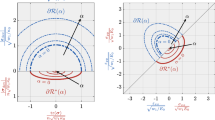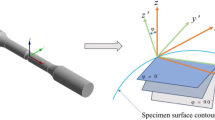Conclusions
-
1.
Using the exact solution as the base, for components of the stress tensor acting along the extension of the central through-crack in an infinite plate exposed to tensile stress, analytical conclusions have been derived for the length of the plastic-strain zone at the tip of a crack of any length.
-
2.
By means of the hypothesis on the constancy of the plastic-strain zone size at the crack tip, analytical relations were obtained for determining the fatigue limit of a material with a crack of any length.
-
3.
It is shown that in a general case the fatigue limit of the material is determined by three characteristics: yield point, size of the plastic strain zone or threshold value of the stress intensity factor, and size of the initial crack. The contribution of these parameters can vary according to crack size.
-
4.
The fatigue limit of the material with a crack not exceeding in length the level (0.03–0.1) (Kth/σ0.2)2 no longer depends on the crack length and is uniquely determined by the yield point of the material. In the case when the size of the crack zone exceeds the level (2.5–8) (Kth/σ0.2)2, the fatigue limit is determined by relation Kth/√MZ.
-
5.
A comparison of experimental and calculated data on the effect of short cracks on the fatigue limit of a number of steel grades showed a satisfactory agreement.
-
6.
Experimental data on the fatigue limit of smooth specimens will agree with the calculated data if it is assumed that the material had a crack commensurable with its grain size.
Similar content being viewed by others
Literature Cited
J. F. Knott, Fundamentals of Fracture Mechanics [Russian translation], Metallurgiya, Moscow (1978).
H. Ohuchida, S. Usami, and A. Nishioka, “Fatigue limit of steel with cracks,” Bull. ASME,18, No. 125, 1185–1193 (1975).
T. H. Topper and M. H. Haddad, “Fracture mechanics analysis for short fatigue cracks,” Can. Metall. Q.,18, No. 2, 207–213 (1979).
V. S. Ivanova, Fatigue Fracture of Metals [in Russian], Metallurgizdat, (1963).
I. V. Kudryavtsev and N. E. Naumchenkov, Fatigue of Welded Structures [in Russian], Mashinostroenie, Moscow (1976).
S. Kotsan'da, Fatigue Fracture of Metals [Russian translation], Metallurgiya, Moscow (1976).
A. Ya. Krasovskii, Brittleness of Metals at Low Temperatures [in Russian], Naukova Dumka, Kiev (1980).
S. Usami and S. Shida, “Elastic-plastic analysis of the fatigue limit for a material with small flaws,” Fatigue Eng. Mater. Struct.,1, No. 4, 471–481 (1979).
Additional information
Moscow. Translated from Problemy Prochnosti, No. 7, pp. 35–40, July, 1983.
Rights and permissions
About this article
Cite this article
Domozhirov, L.I. Theoretical analysis of the effect of short cracks on the fatigue limit of materials. Strength Mater 15, 925–931 (1983). https://doi.org/10.1007/BF01528934
Received:
Issue Date:
DOI: https://doi.org/10.1007/BF01528934




